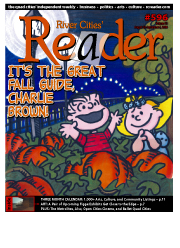 When
the Davenport Museum of Art brought in Lauren Greenfield's Girl
Culture exhibit in 2003, it
was the institution's boldest exhibit to-date. A venue not known
for being confrontational showcased Greenfield's high-gloss
photographs with their blunt, distressing messages about the status
of girls and women in the world.
When
the Davenport Museum of Art brought in Lauren Greenfield's Girl
Culture exhibit in 2003, it
was the institution's boldest exhibit to-date. A venue not known
for being confrontational showcased Greenfield's high-gloss
photographs with their blunt, distressing messages about the status
of girls and women in the world.
This fall, the DMA's descendant, the Figge Art Museum, will be getting edgy again, but in an entirely different way. In addition to the current show of landscape photography (on display through October 8) and an upcoming display of African-American quilts (November 18 through February 11), the Figge will have two exhibits that are likely to alternately unsettle, excite, and confound audiences. And even the landscape and quilt shows break some boundaries.
But the stars of the show this fall will be The Architect's Brother (featuring the work of Robert and Shana ParkeHarrison) and Adventures in a Temperate Climate (a retrospective of work by Martin Mull). The photographic constructions of the ParkeHarrisons and the paintings of Mull - yes, the actor, comedian, and former Red Roof Inn hawker - are startling, engaging, and enigmatic.
The ParkeHarrisons' work (September 2 through October 29) has the hazy texture of antique photographs but with a post-apocalyptic feel that recalls the expressively outré, aggressively odd cinematic works of Terry Gilliam and the Brothers Quay.
On the other hand, Mull's work (October 28 through January 21) combines clean-cut imagery from the 1950s in ways that undermine the cultural idealization of the era.
Unlike Greenfield's work, which has the power to anger and upset audiences because of its highly specific portrayal of recognizable reality, the ParkeHarrisons and Mull make the viewer uneasy with ambiguous motives and imagery. They clearly have a point of view, but it's one that's open to interpretation.
Finding Hope in Vague Dread
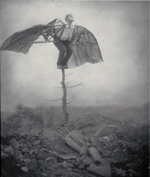 In
the ParkeHarrisons' The
Architect's Brother
exhibit, the 47 works aren't conventional photographs, but
photographed scenes.
"It's a great hybrid between photography and theatre," said
Figge curator Michelle Robinson. "The works are very seductive.
They're large. The surfaces ... you just want to swim in them. ...
And they're varnished. They're just absolutely scrumptious."
In
the ParkeHarrisons' The
Architect's Brother
exhibit, the 47 works aren't conventional photographs, but
photographed scenes.
"It's a great hybrid between photography and theatre," said
Figge curator Michelle Robinson. "The works are very seductive.
They're large. The surfaces ... you just want to swim in them. ...
And they're varnished. They're just absolutely scrumptious."
The resulting artworks are monochromatic and gauzy, like half-remembered dreams in which the images are seared into the memory but the narrative is elusive. The pictures - all of which feature Robert - cluster around repeated motifs: wounds, primitively futuristic technology, scarred landscapes, healing, and transcendence. They are both organic and artificial. Nearly all the works seem particularly interested in the ground beneath their ostensible subjects.
"I think he's asking an open-ended question about how we treat our planet," Robinson said. "I think he wants to pose a series of problems and questions about our relationship to the planet, the history of mankind and what we do to each other, our ideas, our dreams, our hopes ... . He's not giving us an answer."
In both Edison's Light and DaVinci's Wings, the protagonist is strapped into some rickety contraption designed to free him from gravity or the planet. Failure seems certain, but the look of determination on his face in DaVinci's Wings gives pause; in spite of the smoky ruins all around, the character's inventiveness and steadfastness are hopeful.
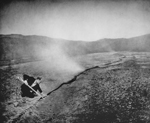 There's
also hope in Mending the Earth,
in which the man is literally sewing together the ground, trying to
erase a steaming fissure. Yet there's no denying the vague dread
that these images cause.
There's
also hope in Mending the Earth,
in which the man is literally sewing together the ground, trying to
erase a steaming fissure. Yet there's no denying the vague dread
that these images cause.
The Architect's Brother certainly seems political, but it's not polemic or didactic. "He's a thoughtful person, and he wants you to be thoughtful," Robinson said.
That ambiguity is evident even in the technique. "It's hard to determine where the light ... is coming from," Robinson said. "All the light is very even. There aren't any shadows."
Robinson conceded that there's a marked contrast between Greenfield's work and the ParkeHarrisons'. "I think Lauren likes to raise questions that raise people's emotion to a fever pitch," she said. "She points out problems that are uncomfortable to talk about. ... This is much more poetic. ... Lauren's much more political. ... As Lauren is hard-edged, Robert and Shana are soft-edged. ... She likes to put in your face a certain problem, and Robert and Shana like to ... come in the back door."
Does Father Know Best?
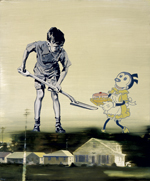 Mull,
of course, is best known as a comic actor in film and television, but
he has focused on his painting over the past decade. "He's a
really good painter," Robinson said, addressing the first reaction
that people naturally have to hearing about an art exhibit by Martin
Mull.
Mull,
of course, is best known as a comic actor in film and television, but
he has focused on his painting over the past decade. "He's a
really good painter," Robinson said, addressing the first reaction
that people naturally have to hearing about an art exhibit by Martin
Mull.
A graduate of the Rhode Island School of Design, Mull uses the Father Knows Best version of the 1950s as his starting points. His paintings are sophisticated and full of loaded images, not at all the sneering and obvious shots one might expect. Adventures in a Temperate Climate features 40 of his works, primarily large oil-on-linen paintings.
"He's kind of peeling back the layers of the onion in an era and in an area ... that was kind of presented as this Leave It to Beaver, Ozzie & Harriet, Father Knows Best world," Robinson said, "where all moms wear dresses and aprons and baked cookies when you got home from school. Dad showed up at 5:30 or 6, and dinner was on the table. Mom stayed home and watched the kids. Maybe the 1950s weren't really like that."
Mull's paintings tend to mine the "the scrubbed-clean look that we all tend to associate with the 1950s," Robinson said.
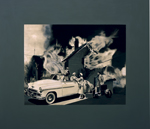 Sometimes
a jarring juxtaposition will undercut that tone, as in The
Importance of an Annual Vacation,
in which casual preparations for a trip are set against the backdrop
of a burning home.
Sometimes
a jarring juxtaposition will undercut that tone, as in The
Importance of an Annual Vacation,
in which casual preparations for a trip are set against the backdrop
of a burning home.
More often, though, Mull's work is subtler. In The Joys of Indoor/Outdoor Living, a man and woman are captured in their sun room. This domestic scene might seem surface-pleasant, except in the way that the subjects appear trapped by glass, prisoners in their own palace. This effect is achieved almost entirely by shadow.
In Parents I, Mull combines unrelated images - Minnie Mouse holding a birthday cake, and a young boy with a shovel, both standing atop the greenish blur of a suburban landscape as if glimpsed from a speeding car - to load the piece up with memories and cultural luggage. One of the interesting components of the work is that the imagery is often so familiar that each observer will bring individual baggage to it. Some might find the painting comforting and whimsical, while others will sense a dark current.
The Jazz of Quilting
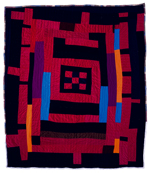 The
exhibit Accidentally on Purpose:
Improvisational African Textiles & African-American Quilts
is originating at the Figge and was drawn from the collection of
California quilt collector Eli Leon. While it might not inhabit the
same daring realm that Mull and the ParkeHarrisons do, it's likely
to confound expectations; these aren't the quilts most of us are
used to seeing.
The
exhibit Accidentally on Purpose:
Improvisational African Textiles & African-American Quilts
is originating at the Figge and was drawn from the collection of
California quilt collector Eli Leon. While it might not inhabit the
same daring realm that Mull and the ParkeHarrisons do, it's likely
to confound expectations; these aren't the quilts most of us are
used to seeing.
"The premise is that there is a kind of aesthetic that many African-American women were taught by their mothers, grandmothers, great-grandmothers, and that aesthetic ... was translated and transported by African slaves," Robinson explained. (In addition to the quilts themselves, the exhibits includes examples of African textiles for comparison. The museum will also be creating the catalog for the exhibit, which features 120 works.)
While European quilters learn to follow a pattern - to maintain it -African-American women improvise on themes and motifs. The result in this exhibit is quilts that are vibrant and, in Robinson's word, "gorgeous. ... There's something about these that's almost like jazz." It's easy to get lost in the patterns.
 Robinson
explained that these are not "show quilts; they're all used, and
they look worn. These were all made to be used. In fact, Eli has
gotten some of these at garage sales."
Robinson
explained that these are not "show quilts; they're all used, and
they look worn. These were all made to be used. In fact, Eli has
gotten some of these at garage sales."
That the quilts -primarily made in the second half of the 20th Century - were intended to be functional, that they weren't made for art's sake, and that quilting is a traditional art passed through the oral tradition makes this exhibit more "folk art" than "fine art." And in that way the show is a good match for much of the museum's Haitian collection, as well as newly acquired African art objects.
The exhibit will also be an opportunity for the Figge to explore acquiring more folk art, Robinson said.
What Is Landscape?
The most conventional exhibit in the Figge's fall lineup is the current landscape show Seen Outside: Photographs from the Collection. Yet even it is atypical.
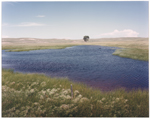 It
starts with the name, which sets a broad definition of "landscape"
that encompasses the urban and human in addition to the natural and
beautiful. "I'm trying to get everybody out of the niche that
landscape photography is ... Yosemite Valley," Robinson said. "When
you step outside, you're the one that's deciding what's a
landscape."
It
starts with the name, which sets a broad definition of "landscape"
that encompasses the urban and human in addition to the natural and
beautiful. "I'm trying to get everybody out of the niche that
landscape photography is ... Yosemite Valley," Robinson said. "When
you step outside, you're the one that's deciding what's a
landscape."
The 35-work exhibit is meant to showcase the museum's photography collection, which is still modest (less than 100 items) but growing, with Robinson having purchased several dozen photographs over the past eight years.
The show started with a handful of photographs by Aernout Overbeeke, who in the 1980s photographed scenes along the Mississippi River. Robinson said Overbeeke has "a Dutch eye for landscape ... really conscious of a flat horizon line, and big sky, and what happens in the sky. ... His entire viewpoint is stretched out [horizontally]. Really long and skinny, like he's emphasizing the lines."
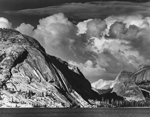 The
tent of Seen Outside
is large enough to accommodate Greenfield, Ansel Adams, and local
photographers such as John Deason. Robinson's juxtapositions are
smart, such as putting an Overbeeke that defies expectations of a
grain-elevator photograph next to what one might typically expect of
a farmscape.
The
tent of Seen Outside
is large enough to accommodate Greenfield, Ansel Adams, and local
photographers such as John Deason. Robinson's juxtapositions are
smart, such as putting an Overbeeke that defies expectations of a
grain-elevator photograph next to what one might typically expect of
a farmscape.
Even the clichés are fresh. David Hockney's Grand Canyon picture is pieced together from dozens of snapshots and unfolds in an irregular shape.
And Peter Brown's Aquifer Lake, Sand Hills, South of Rushville, Nebraska ripples in the breeze with detail and color more painterly and surreal than photographic. It's appropriate that in a strong collection of autumn exhibits, even the landscape show itself borders on the transcendent.
For information on exhibit-related programming at the Figge, see the River Cities' Reader calendar starting on page 11.
The ParkeHarrisons will be participating in a discussion of their work at 7 p.m. on September 28. Programming for the Martin Mull exhibit had not been confirmed at press time.










